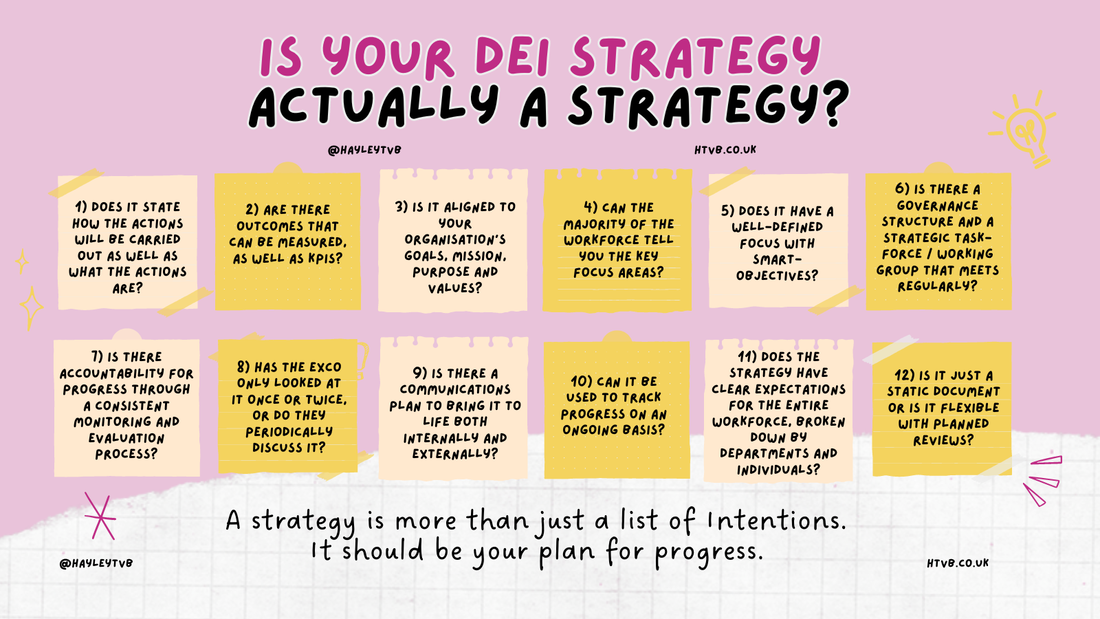|
In this post, I am sharing some key elements of a successful DEI strategy. When it comes to DEI strategy developments, you need to think about these key elements that are often overlooked. Read along as we play a little game of bingo to determine whether your DEI strategy is indeed a strategy or just a list of good intentions. If you are developing a strategy, ask yourself these questions to ensure it is effective. If you are not happy with your answers, get in touch with me and we can support! 1) Does it state how the actions will be carried out as well as what the actions are? A DEI strategy is more than just a list of intentions. It should be a comprehensive plan for progress, outlining not just what the actions will be, but also how they will be carried out. So, ask yourself, does your DEI strategy detail the how and what of your actions? 2) Are there outcomes that can be measured, as well as KPIs? A key part of any strategy is the ability to track progress and measure success. Does your DEI strategy have measurable outcomes and Key Performance Indicators (KPIs)? This is vital in evaluating whether your DEI strategy is making a tangible difference within your organization. 3) Is it aligned to your organisation’s goals, mission, purpose and values? Your DEI strategy should be an integral part of your business planning, aligning with its goals, mission, purpose, and values. Can you confidently say that your DEI strategy aligns with your organisation's key objectives and is seen as something that can help your organisation achieve its business goals? 4) Can the majority of the workforce tell you the key focus areas? The success of a DEI strategy largely depends on employee engagement and awareness. Would the majority of your workforce be able to tell you the key focus areas of your DEI strategy at the very least? 5) Does it have a well-defined focus with SMART-objectives? A well-defined focus, along with SMART (Specific, Measurable, Achievable, Relevant, Time-bound) objectives, forms the backbone of a successful strategy. 6) Is there a governance structure and a strategic task-force / working group that meets regularly? To ensure the implementation and effectiveness of your DEI strategy, you need a governance structure in place and a strategic task force or working group that meets regularly. Otherwise your strategy will remain just a document. 7) Is there accountability for progress through a consistent monitoring and evaluation process? Accountability is crucial for the success of any strategy. Within your strategy, you should ensure that responsibilities are clearly defined and that all those responsible are aware of their roles and expectations. By upholding accountability at all levels, a strategy is more likely to be executed efficiently and goals are more likely to be achieved. 8) Has the ExCo only looked at it once or twice, or do they periodically discuss it? The commitment of the executive team is often a determinant of a strategy's success. It is essential that the leadership not only reviews the strategy once or twice but also prioritizes it by regularly discussing it during their meetings. 9) Is there a communications plan to bring it to life both internally and externally? Having a comprehensive communications plan is essential for bringing your strategy to life. Internally, effective communication ensures that all team members are aware of the goals and initiatives outlined in the strategy. Incorporating communication strategies such as town hall meetings, newsletters, social media campaigns, and diversity reports can help build traction and keep the workforce informed and engaged. Externally, an aligned communications plan should help create credibility and visibility for your organization's strategic direction to stakeholders, customers, and the public through things like press releases, social media updates, website announcements, and industry events. 10) Can it be used to track progress on an ongoing basis? A strategy needs to be regularly monitored and tracked so that you can hold yourself accountable for progress. A robust tracking and monitoring tool should be developed at the same time as the strategy. This seems obvious but so many strategies miss this key part as people perceive the creation of the strategy itself as the goal, rather than a means to achieve wider goals. 11) Does the strategy have clear expectations for the entire workforce, broken down by departments and individuals? The strategy needs to establish clear expectations for the entire workforce, outlining roles for both departments and individuals, to ensure everyone comprehends their part in the DEI strategy. This is where I see most strategies fail. Whilst there are key players who are responsible, accountable, consulted and informed, everyone has a role to play. Does your strategy convey this? 12) Is it just a static document or is it flexible with planned reviews? Regular reviews and assessments are necessary to ensure that the DEI strategy remains relevant. By actively seeking feedback, staying informed on best practices, and being willing to make adjustments, organizations can create a DEI strategy that is not only robust but also responsive to the ever-changing landscape of diversity, equity, and inclusion. Can we help you develop a more effective DEI strategy and save you time and money? Get in touch today! Hayley BennettHTVB Founder, DEI Consultant
0 Comments
Leave a Reply. |


 RSS Feed
RSS Feed